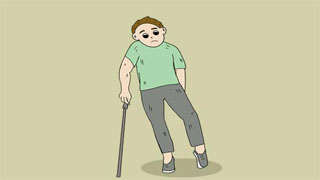
Leg pain is a common problem that can be caused by various reasons, such as muscle strains, spasms, sciatica, prolonged sitting, osteoarthritis, etc. Appropriate exercise and stretching can help alleviate symptoms.
15 stretching rehabilitation exercise methods for treating leg pain:
1. Assist in stretching the leg muscles
-Target muscle: Leg muscles
-Step: Sit on the floor, stretch your legs straight, wrap a strap around your feet, lie down, lift your legs and pull them vertically with your arms, hold for 30-60 seconds, and repeat with a different edge.
-Benefits: Gentle stretching, suitable for all levels of exercisers, can identify and repair flexibility imbalances.
-Tip: If your legs are trembling or burning, you should relax and try different leg positions to keep your shoulders relaxed.
2. Prone quadriceps stretching
-Target muscles: quadriceps femoris, hip flexors
-Step: Lie on your back, place your head on your forearm, bend your right leg and use your hands to grab your ankle and pull it towards your buttocks. Hold for 30-60 seconds, then repeat the process by changing sides.
-Benefits: Comfortable stretching, aligning hips and knees, suitable for long-term maintenance.
-Tip: Keep the neck relaxed, use a towel to assist in grabbing the ankle, and avoid excessive stretching.
3. Stand up and stretch your calves
-Target muscles: gastrocnemius, soleus
-Step: Stand at the edge of the steps, let your heels move freely, use your weight to relax your heels, and hold for 30-60 seconds.
-Benefits: Easy to use, weight stretching can be done anytime, anywhere.
-Tip: Slightly bend the knee to stimulate the soleus muscle, which can be done on one leg, using the arm to maintain balance.
4. Half kneeling hip flexor muscle extension
-Target muscles: hip flexors, quadriceps femoris (rectus femoris)
-Step: Kneel on the mat, take one leg forward and bend, relax your hips and feel the stretch, hold for 30-60 seconds, and repeat with a different leg.
-Benefits: Gentle hip opening and improved posture are the antidote for sedentary individuals.
-Tip: Adjust the position of the front and rear legs to increase stretch, keep the torso upright, and cross your arms behind you to stretch.
5. Sitting posture pear shaped muscle stretching
-Target muscles: piriformis, gluteus maximus, gluteus maximus, gluteus medius
-Step: Sit in a chair with your ankles crossed over your knees, press your knees with both hands and lean forward, hold for 30-60 seconds, and repeat with a different leg.
-Benefits: Can be done anywhere, can quickly relieve sciatica, break sedentary habits.
-Tip: When leaning forward, be careful not to bow your back, do not exert excessive pressure on your legs, and twist your shoulders to increase stretch.
6. Stand up with IT belt stretching
-Target muscles: ITB band, hip abductor muscle
-Step: Stand against the wall, cross your right leg with your left leg, support the wall with your right hand, and push your hips towards the wall to feel the stretch. Hold for 30-60 seconds and repeat the process by changing sides.
-Benefits: Easy to operate, can be performed at any time, and can quickly relieve pain.
-Tip: Maintain a right angle between the hips and shoulders, tilt the hips and deepen the stretching, or do it independently.
7. Sitting adductor muscle extension
-Target muscles: adductor longus, adductor brevis, adductor maximus
-Step: Sit on the ground, bend your legs and press the soles of your feet together, grab your ankles and press your knees with your elbows, and hold for 30-60 seconds.
-Benefits: Effectively stretches adductor muscles and groin, comfortable and simple, suitable for all levels of exercisers.
-Tip: Sitting on a cushion is more comfortable. If you cannot maintain your posture, you can use yoga tiles or other techniques to keep your upper body relaxed.
8. Baby style (Balasana)
-Target muscles: erector spinae, gluteus maximus, fascia lata, gastrocnemius, soleus
-Step: Kneel down on all fours, sit on your heels, extend your arms forward, and keep your chest close to your thighs for 30-60 seconds.
-Benefits: Relaxing and stretching, releasing tension in the buttocks and lower back, is an excellent relaxation exercise.
-Tip: Place your arms on both sides to emphasize the muscles of your lower body, use a cushion to increase comfort, and inhale to relax.
9. Lie down with legs reversed
-Target muscles: all lower body muscles
-Step: Lie on your back against the wall, support your legs vertically against the wall, and hold for 3-5 minutes before lowering.
-Benefits: Very relaxing, promotes lymphatic drainage and circulation, relieves leg tension and pressure.
-Tip: Stretch your hips close to the wall, tilt your legs outward to stretch your adductor muscles, and do sleep aids before bedtime.
10. Hip bridge
-Target muscles: gluteus maximus, hamstring, erector spinae
-Step: Lie on your back, bend your legs, tighten your abdominal muscles, lift your hips in a straight line with your heels, and repeat.
-Benefits: Low tech and efficient hip strengthening exercises, no equipment required, suitable for the waist and back.
-Tip: Use your knee to push your hand or use tools to increase hip joint, and pull your heel to exercise your leg muscles, which can increase difficulty.
11. Raise the calf
-Target muscles: gastrocnemius, soleus
-Step: Stand at the edge of the steps, grab the handrail, straighten your legs and lower your heels, then tiptoe and repeat alternately.
-Benefit: No equipment required, it is an effective stretching and strengthening exercise suitable for all fitness levels.
-Tip: Maximum range of motion, slow movement, can increase difficulty with dumbbells or one leg.
12. Ankle rotation
-Target muscles: gastrocnemius, soleus, tibialis anterior, tibialis posterior, peroneal long and short muscles
-Step: Sit down and straighten your legs, then turn your ankles clockwise and counterclockwise for 1-2 minutes each.
-Benefits: Can be done anywhere, can increase lower limb blood flow, mobilize and strengthen ankle joints and muscles, or prevent DVT.
-Tip: Barefoot or alternate rotation, draw large circles to increase stretch.
13. Asian squat
-Target muscles: gluteus maximus, quadriceps femoris, hamstring, abductor, adductor, gastrocnemius, soleus, erector spinae
-Step: Stand with feet apart, toes extended, knees bent and squat deeply, arms supporting knees, hold for a few minutes before standing up.
-Benefit: It can simultaneously stretch the muscles of the lower body, move the ankles, knees, and buttocks, and is a good medicine for sedentary people.
-Tip: Use heel pads to facilitate squatting, keep your chest straight to avoid bending over, and use steps or mats when tired.
14. Rolling of foam shaft
-Target muscles: quadriceps, hamstring, gluteus maximus, abductor, adductor, gastrocnemius, soleus, etc
-Step: Lie on your back or side, use a weight roller to roll the affected area up and down for 1-2 minutes, repeat.
-Benefits: Self massage relieves muscle tension, improves muscle mass, increases blood flow, and relieves pain.
-Tip: Do not overdo it, warm up and gradually transition from the soft axis to the hard axis.
15. Walking
-Target muscles: quadriceps, hamstring, gluteus maximus, abductor, adductor, gastrocnemius, soleus, etc
-Step: Go for a walk, take short or long walks multiple times a day, and look for walking opportunities.
-Benefits: Helps with weight loss and improves health, creates a favorable environment, and is a good way to relieve stress.
-Tip: Use your phone to record your steps, wear comfortable shoes and socks, and walk more during the day.
Frequently Asked Questions:
1. Frequency of leg exercises and stretching: Depending on the severity and cause of the pain, some can be done daily. If caused by potential health conditions, follow medical advice.
2. Exercise suggestions for people with limited mobility or leg injuries: Avoid activities that worsen pain and choose comfortable and convenient exercises.
3. Warm up suggestion: Gentle warm-up or slow entry into exercise may be helpful if muscles are not adapted to relaxation.
4. Exercises to relieve leg pain after running: including leg stretching, rolling of foam shaft, inversion, and alternate cold and hot application. It is also beneficial to strengthen leg strength.
5. Complementary therapies: lose weight, stay hydrated, eat more fruits and vegetables, sit less and move more, massage, seek professional advice, etc.
6. Practice time: Strengthening exercises should be done before exercise, while stretching and relaxation exercises should be done after exercise, but not absolutely.
7. Recommended exercise with limited time: foam shaft rolling combined with walking and Asian squatting can effectively relieve pain.
In short, leg pain can be relieved through appropriate exercise, trying different methods, and finding a prescription that suits oneself.


